Short Term Wind Power Prediction Based on Data Regression and Enhanced Support Vector Machine
Abstract
1. Introduction
2. Model Structure Optimization
2.1. Data Preprocessing
2.1.1. Wind Speed Prediction Process
2.1.2. Construction of Power Generation Model
2.2. Wind Power Generation
2.3. Performance Measurements
3. Proposed Bee Swarm Optimization with Support Vector Machine Algorithm
3.1. Least Square Support Vector Machine
- : A vector used to describe the style or attributes of a piece of data.
- .
- : The target, usually expressed as {±1} (assuming the target is divided into two categories), in which +1 and −1 indicate two different categories.
- .
3.2. Enhanced Bee Swarm Optimization Algorithm
- (1)
- Worker Bee Working Mode
- j: The number of worker bee populations
- : The old nectar location.
- : The new nectar location.
- : The worker bee’s own cognitive ability.
- : The group cognitive ability of the worker bees.
- : A random number between 0 and 1.
- : The best search location for the worker bees themselves.
- : The best search location for the worker bee colony.
- : A reverse search judgment.
- : The maximum number of searches.
- (2)
- Follower Bee working mode
- k: The number of follower bee groups;
- : A position randomly selected by the follower bee according to Equation (26) at the t-th iteration.
- (3)
- Scouting Bee Working Mode
- s: The number of scouting bees.
- r: A random number between 0 and 1.
- : The average value of all group positions at the t-th iteration.
- round: Take the integer.
- The flow of the bee swarm algorithm is as follows:
- (a)
- Generate initial settings and data, including the maximum number of iterations, the number of groups, the number of variables, and the upper and lower limits. Generate the N group variable combination, calculate the fitness value of the variable combination , and record the best solution.
- (b)
- The worker bees conduct proximity searches.
- (c)
- Calculate the benefit rate of all variable combinations with as the probability and follow the bees using the roulette mechanism to randomly select a honey source for further searching.
- (d)
- The scouting bee generates a new position based on the comparison between the t-th iteration best solution and the group position average.
- (e)
- Repeat steps (a) to (d) to search the best solution in the whole area.
- (f)
- Determine whether the upper limit of the number of iterations is reached. If not, continue the iteration; if the upper limit is exceeded, output the result.
3.3. Wind Power Forecasting Process
- Part 1: Apply data regression analysis to select the modeling data.
- Part 2: Apply the bee swarm algorithm to solve the best setting parameters for the support vector machine.
- Part 3: Use EBSO_LSSVM to perform wind speed prediction.
4. Simulation Results and Analysis
4.1. Short Term Wind Power Forecasting (Hours)
4.2. Ultra-Short-Term Wind Speed Forecasting (10 min)
4.3. DR-SVM Performance Evaluation
5. Conclusions
5.1. Wind Speed Prediction
5.2. Construction of the Power Generation Model and Wind Power Forecast
Author Contributions
Funding
Acknowledgments
Conflicts of Interest
References
- Landberg, L. Short-term prediction of local wind conditions. J. Wind Eng. Ind. Aerodyn. 2001, 89, 235–245. [Google Scholar] [CrossRef]
- Shao, H.; Deng, X. Adaboosting neural network for short-term wind speed forecasting based on seasonal characteristics analysis and lag space estimation. Comput. Model. Eng. Sci. 2018, 114, 277–293. [Google Scholar]
- Beyer, H.D.; Mellinghoff, H.; Monnich, K.; Waldl, H.P. Forecast of regional power output of wind turbines. In Proceedings of the European Wind Energy Conference, Nice, France, 1–5 March 1999; p. 1073. [Google Scholar]
- Landberg, L. Short-term prediction of the power production from wind farms. J. Wind Eng. Ind. Aerodyn. 1999, 80, 207–220. [Google Scholar] [CrossRef]
- Focken, U.; Lange, M.; Waldl, H.P. Previento–A wind power prediction System with an innovative upscaling algorithm. In Proceedings of the 2001 European Wind Energy Association Conference, EWEC’01, Copenhagen, Danmark, 2 July 2001; pp. 826–829. [Google Scholar]
- Xu, Q.; He, D.; Zhang, N.; Kang, C.; Xia, Q.; Bai, J.; Huang, J. A short-term wind power forecasting approach with adjustment of numerical weather prediction input by data mining. IEEE Trans. Sustain. Energy 2015, 6, 1283–1291. [Google Scholar] [CrossRef]
- Felder, M.; Kaifel, A.; Graves, A. Wind power prediction using mixture density recurrent neural networks. In Proceedings of the Poster Presentation Gehalten AUF DER European Wind Energy Conference 2010, Warsaw, Poland, 23 April 2010. [Google Scholar]
- Soman, S.S.; Zareipour, H.; Malik, O.; Mandal, P. A review of wind power and wind speed forecasting methods with different time horizons. In Proceedings of the 2010 North American Power Symposium, Arlington, TX, USA, 26–28 September 2010. [Google Scholar]
- Giebel, G.; Landberg, L.; Nielsen, T.S.; Madsen, H. The Zephyr-project. The next generation prediction system (poster). In Proceedings of the CD-ROM European Wind Energy Association (EWEA) 2002, Paris, France, 2–5 April 2002. [Google Scholar]
- Jorgensen, J.; Moehrlen, C.; Gallaghoir, B.O.; Mckeogh, E. HIRPOM: Description of an operational numerical wind power prediction model for large scale integration of on-and offshore wind power in Denmark. In Proceedings of the Poster on the Global Wind Power Conference and Exhibition, London, UK, 1 January–30 September 2002. [Google Scholar]
- Gu, X.; Wang, X. A review on wind power forecast technologies. Power Syst. Technol. 2007, 31, 335–338. [Google Scholar]
- Yan, J.; Li, K.; Bai, E.; Zhao, X.; Xue, Y.; Foley, A.M. Analytical Iterative Multistep Interval Forecasts of Wind Generation Based on TLGP. IEEE Trans. Sustain. Energy 2018, 10, 625–636. [Google Scholar] [CrossRef]
- Wang, L.; Yang, G.; Gao, S. A review on modeling and forecasting of wind power. Prot. Control Power Syst. 2009, 37, 118–121. [Google Scholar]
- Gong, W.; Meyer, F.J.; Liu, S.; Hanssen, R.F. Temporal Filtering of InSAR Data Using Statistical Parameters From NWP Models. IEEE Trans. Geosci. Remote Sens. 2015, 53, 4033–4044. [Google Scholar] [CrossRef]
- Carpinone, A.; Giorgio, M.; Langella, R.; Testa, A. Markov chain modeling for very-short-term wind power forecasting. Electr. Power Syst. Res. 2015, 122, 152–158. [Google Scholar] [CrossRef]
- Karadas, M.; Celik, H.M.; Serpen, U.; Toksoy, M. Multiple regression analysis of performance parameters of a binary cycle geothermal power plant. Geothermics 2015, 54, 68–75. [Google Scholar] [CrossRef]
- Cadenas, E.; Jaramillo, O.A.; Rivera, W. Analysis and forecasting of wind velocity in chetumal, quintana roo, using the single exponential smoothing method. Renew. Energy 2010, 35, 925–930. [Google Scholar] [CrossRef]
- Babazadeh, H.; Gao, W.; Cheng, L.; Lin, J. An hour ahead wind speed prediction by Kalman filter. In Proceedings of the 2012 IEEE Power Electronics and Machines in Wind Applications, Denver, CO, USA, 16–18 July 2012. [Google Scholar]
- Zhang, J.; Wang, C. Application of ARMA model in ultra-short term prediction of wind power. In Proceedings of the International Conference on Computer Sciences and Applications, San Francisco, CA, USA, 23–25 October 2013. [Google Scholar]
- Tagliaferri, F.; Viola, I.M.; Flay, R.G.J. Wind direction forecasting with artificial neural networks and support vector machines. Ocean Eng. 2015, 97, 65–73. [Google Scholar] [CrossRef]
- Wang, X.; Zheng, Y.; Li, L.; Zhou, L.; Yao, G.; Huang, T. Short-term wind power prediction based on wavelet decomposition and extreme learning machine. In Proceedings of the Advances in Neural Networks 9th International Symposium on Neural Networks, Shenyang, China, 11–14 July 2012. [Google Scholar]
- Zhang, Q.; Lai, K.K.; Niu, D.; Wang, Q.; Zhang, X. A fuzzy group forecasting model based on least squares support vector machine (LS-SVM) for short-term wind power. Energies 2012, 5, 3329–3346. [Google Scholar] [CrossRef]
- Zeng, J.; Qiao, W. Short-term solar power prediction using a support vector machine. Renew. Energy 2013, 52, 118–127. [Google Scholar] [CrossRef]
- Lin, W.M.; Hong, C.M.; Chen, C.H. Neural-network-based MPPT control of a stand-alone hybrid power generation system. IEEE Trans. Power Electron. 2011, 26, 3571–3581. [Google Scholar] [CrossRef]
- Alencar, D.B.; Affonso, C.M.; Oliveira, R.C.L.; Rodríguez, J.L.M.; Leite, J.C.; Filho, J.C.R. Different models for forecasting wind power generation: Case study. Energies 2017, 10, 1976. [Google Scholar]
- Karaboga, D.; Basturk, B. A powerful and efficient algorithm for numerical function optimization: Artificial bee colony (ABC) algorithm. J. Glob. Optim. 2007, 39, 459–471. [Google Scholar] [CrossRef]
- Taher, N.; Faranak, G. Enhanced bee swarm optimization algorithm for dynamic economic dispatch. IEEE Syst. J. 2013, 7, 4. [Google Scholar]
- Cortes, C.; Vapnik, V. Support-Vector Networks. Mach. Learn. 1995, 20, 273–297. [Google Scholar] [CrossRef]
- Burges, C.J.C. A Tutorial on Support Vector Machines for Pattern Recognition. Data Min. Knowl. 1998, 2, 1–47. [Google Scholar]
- Chang, W.Y. Wind energy conversion system power forecasting using radial basis function neural network. Appl. Mech. Mater. 2013, 284–287, 1067–1071. [Google Scholar] [CrossRef]
- Zhou, J.Y.; Shi, J.; Li, G. Fine tuning support vector machines for short-term wind speed forecasting. Energy Convers. Manag. 2011, 52, 1990–1998. [Google Scholar] [CrossRef]
- Deng, X.; Shao, H.; Hu, C.; Jiang, D.; Jiang, Y. Wind power forecasting methods based on deep learning: A Survey. Comput. Model. Eng. Sci. 2020, 122, 273–301. [Google Scholar] [CrossRef]
- Sana, M.; Turki, A.A.; Sameeh, U.; Aisha, F.; Nadeem, J.; Tanzila, S. Exploiting deep learning for wind power forecasting based on big data analytics. Appl. Sci. 2019, 9, 4417. [Google Scholar]
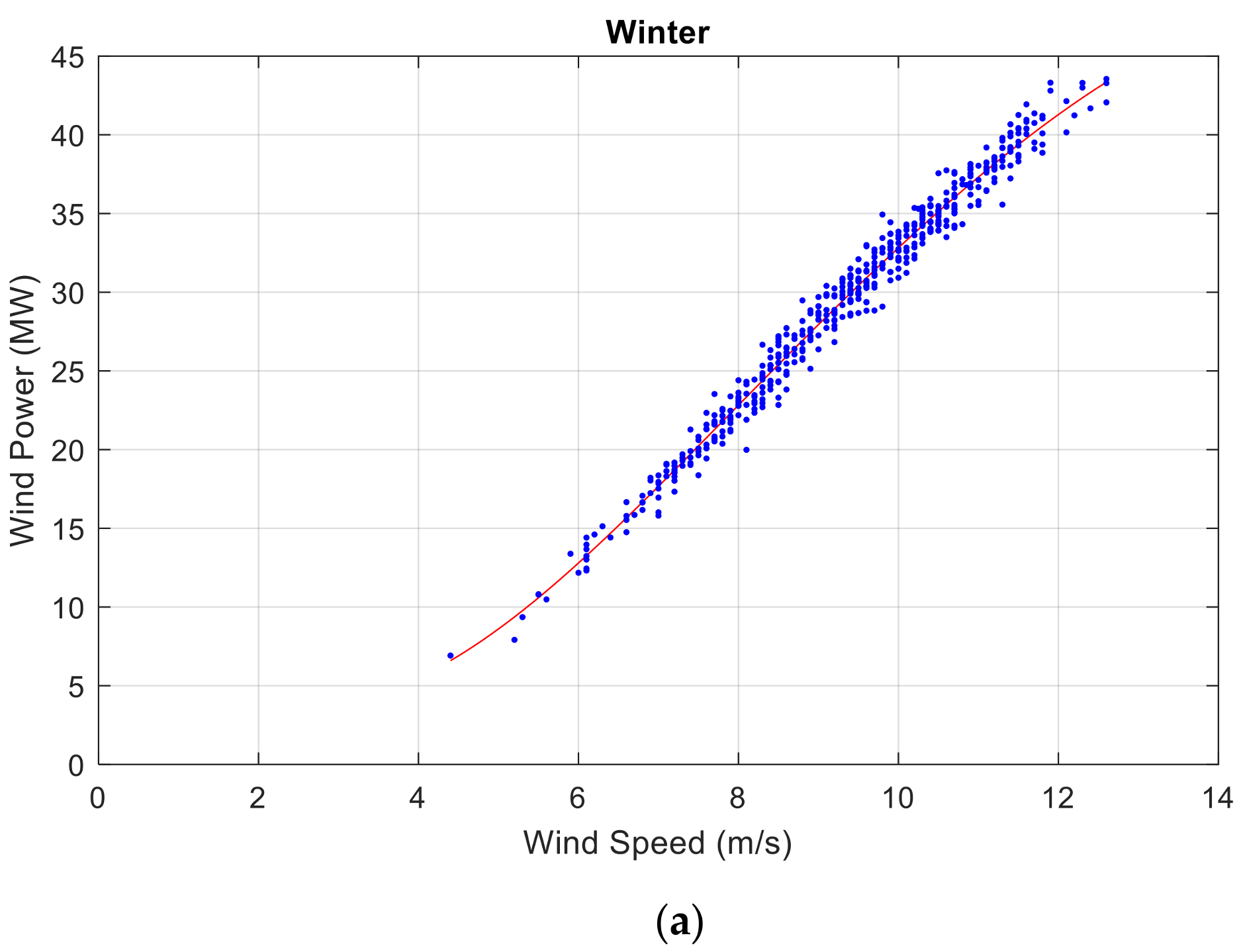
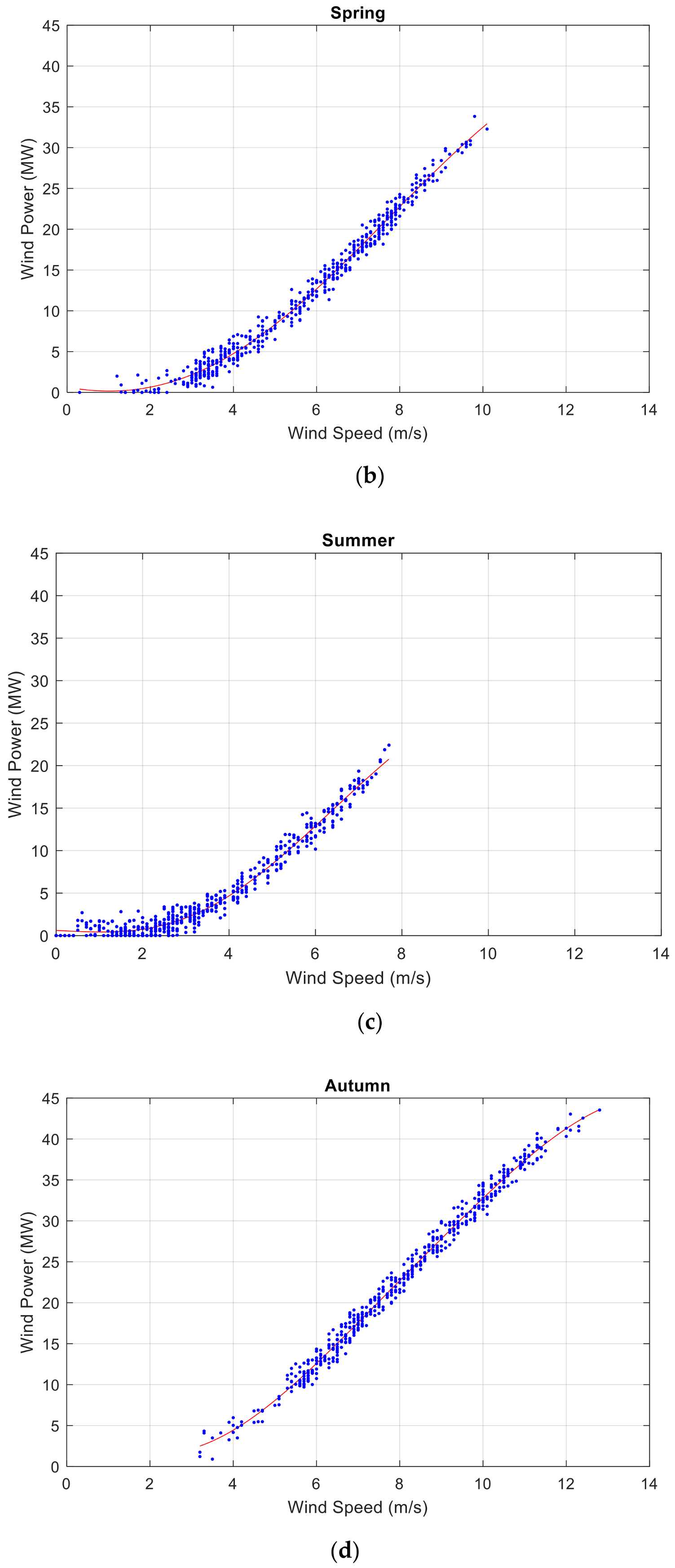




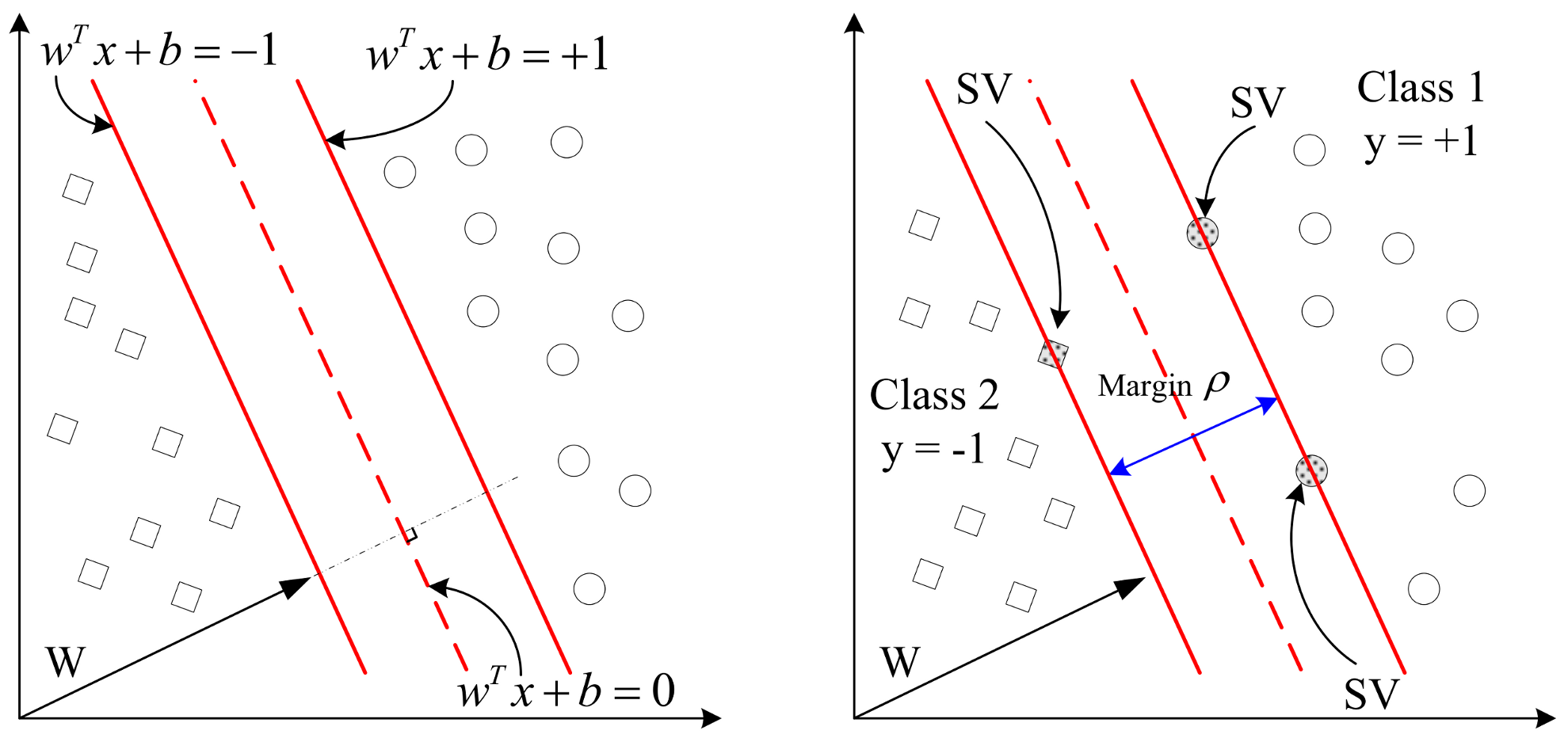


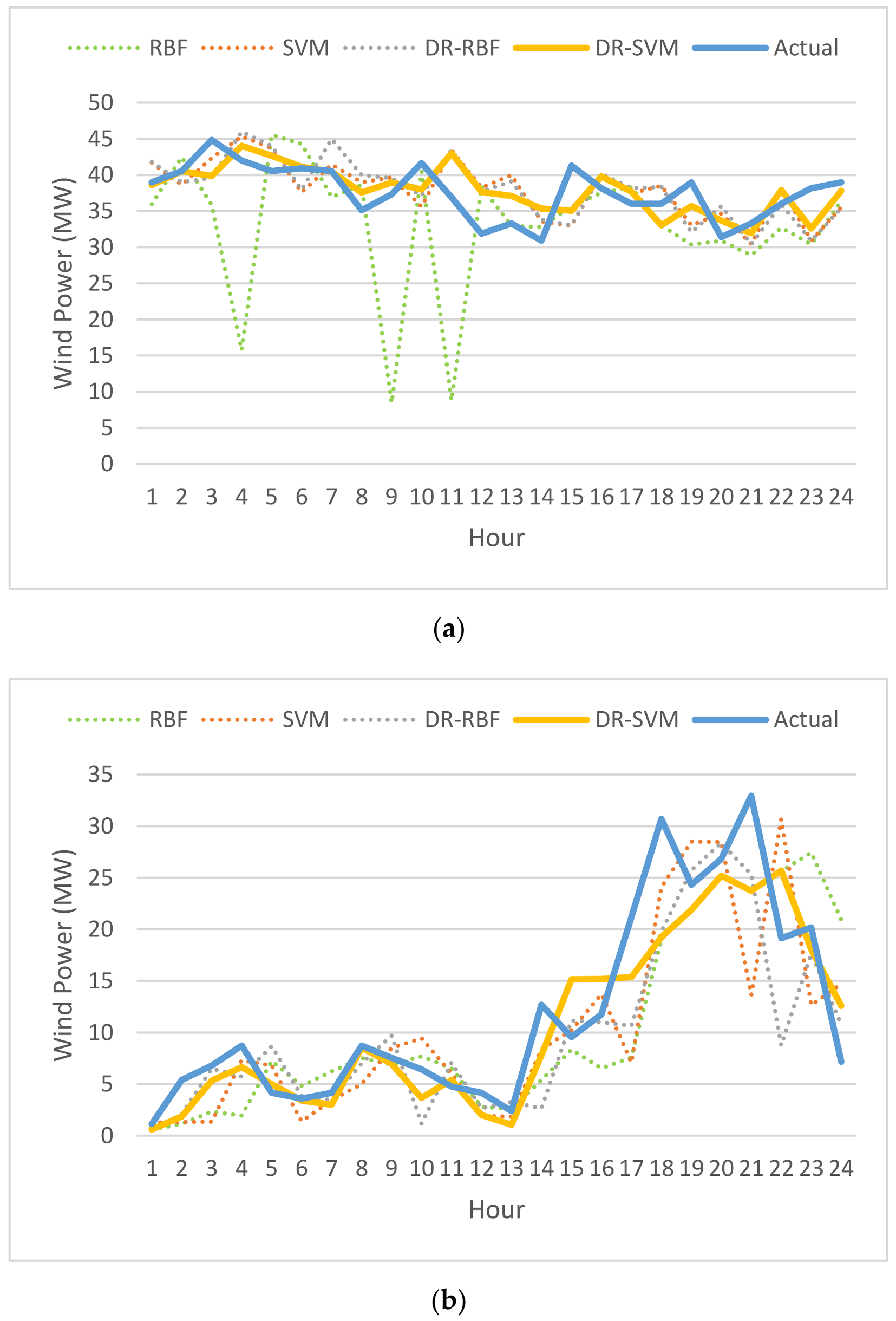
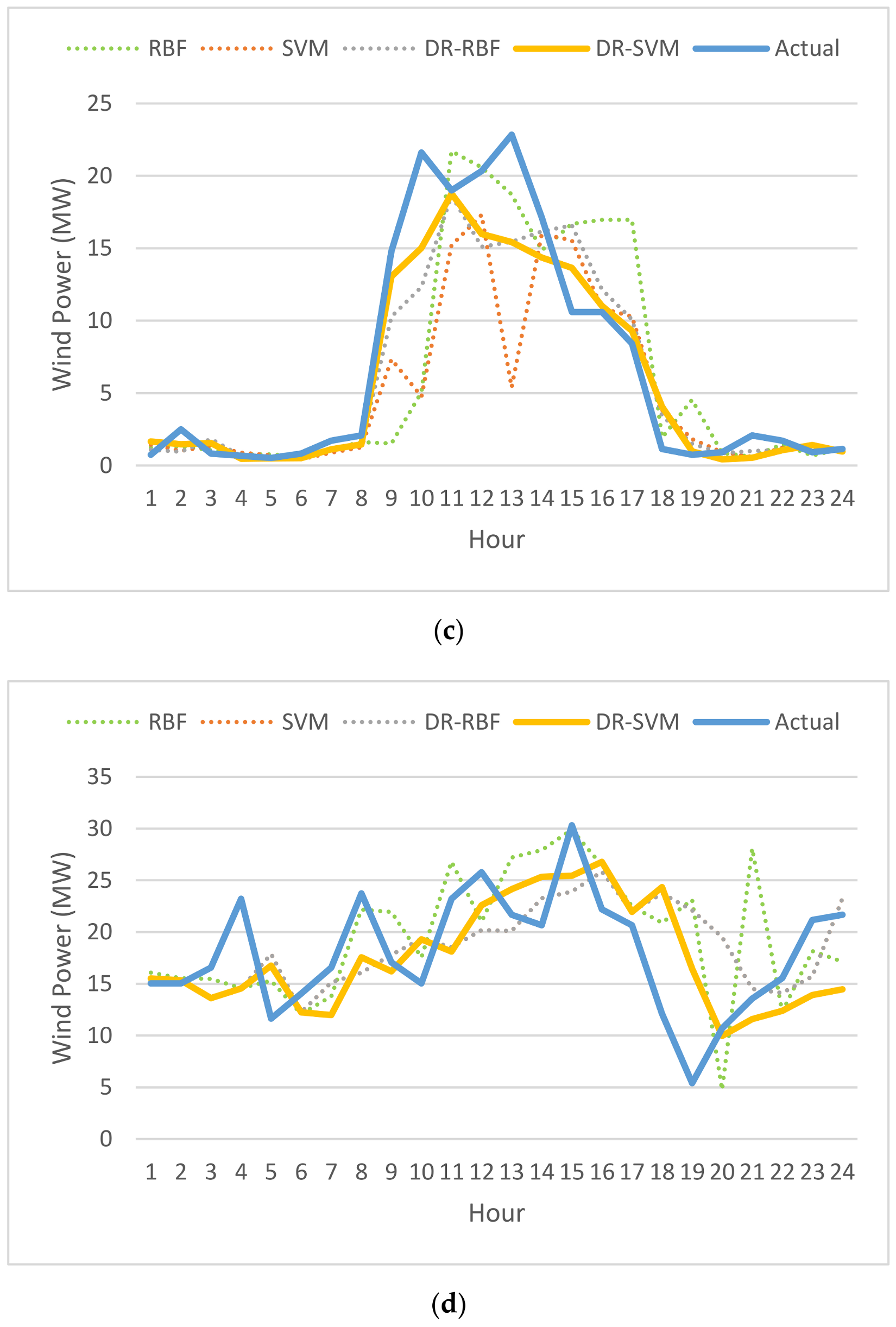
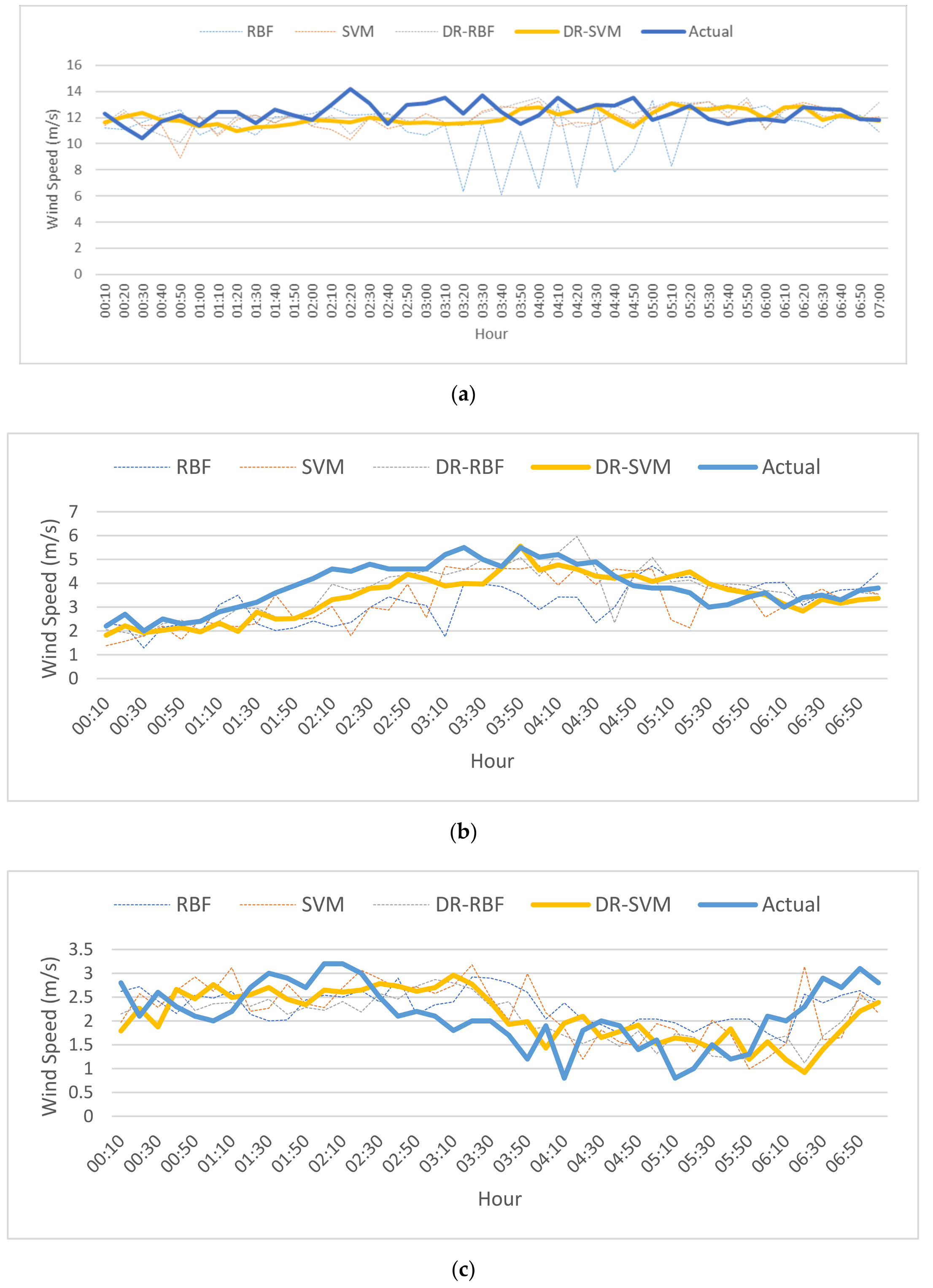

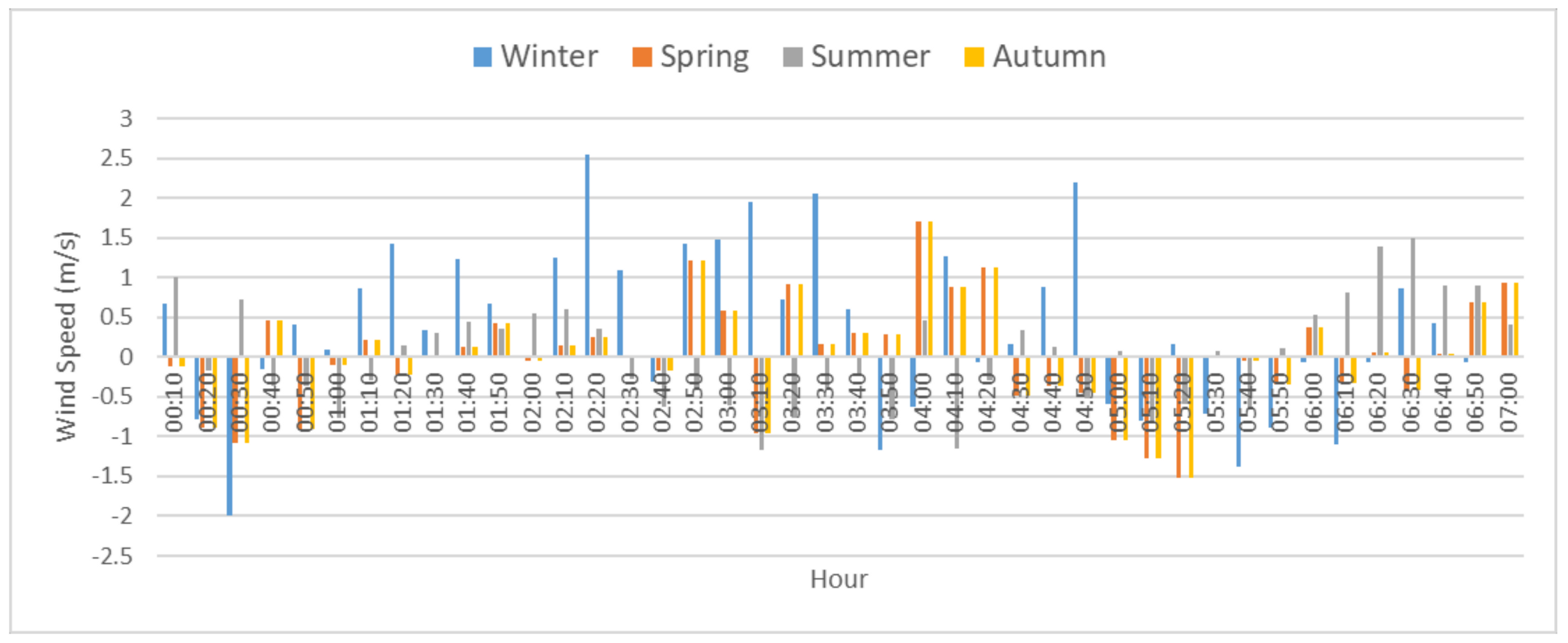
| Seasons | Error | 0:10~6:00 h (Data 36) | 0:10~24:00 h (Data 144) | ||||||
|---|---|---|---|---|---|---|---|---|---|
| RBF | SVM | DR-RBF | DR-SVM | RBF | SVM | DR-RBF | DR-SVM | ||
| Winter (December 2018~February 2019) | VMED (m/s) | 12.369 | 12.369 | 12.369 | 12.369 | 11.096 | 11.096 | 11.096 | 11.096 |
| MAE (m/s) | 1.803 | 1.137 | 1.089 | 0.916 | 1.294 | 0.918 | 0.889 | 0.762 | |
| 21 January 2019 | RMSE (m/s) | 2.574 | 1.387 | 1.264 | 1.127 | 2.038 | 1.157 | 1.105 | 0.953 |
| MAPE (%) | 14.58 | 9.19 | 8.80 | 7.40 | 11.66 | 8.28 | 8.01 | 6.86 | |
| Spring (March 2019~May 2019) | VMED (m/s) | 3.914 | 3.914 | 3.914 | 3.914 | 5.588 | 5.588 | 5.588 | 5.588 |
| MAE (m/s) | 1.172 | 0.896 | 0.572 | 0.622 | 1.257 | 1.094 | 1.071 | 0.856 | |
| 6 May 2019 | RMSE (m/s) | 1.413 | 1.083 | 0.730 | 0.755 | 1.573 | 1.459 | 1.521 | 1.097 |
| MAPE (%) | 29.95 | 22.88 | 14.62 | 15.88 | 22.50 | 19.58 | 19.16 | 15.31 | |
| Summer (June 2019~August 2019) | VMED (m/s) | 3.914 | 2.047 | 2.047 | 2.047 | 5.588 | 3.874 | 3.874 | 3.874 |
| MAE (m/s) | 1.172 | 0.573 | 0.484 | 0.486 | 1.257 | 0.736 | 0.646 | 0.616 | |
| 22 July 2019 | RMSE (m/s) | 1.413 | 0.672 | 0.557 | 0.561 | 1.573 | 1.029 | 0.834 | 0.807 |
| MAPE (%) | 29.95 | 28.01 | 23.64 | 23.73 | 22.50 | 18.99 | 16.69 | 15.90 | |
| Autumn (September 2019~November 2019) | VMED (m/s) | 6.503 | 6.503 | 6.503 | 6.503 | 7.021 | 7.021 | 7.021 | 7.021 |
| MAE (m/s) | 0.521 | 0.537 | 0.486 | 0.533 | 0.901 | 0.796 | 0.751 | 0.659 | |
| 21 October 2019 | RMSE (m/s) | 0.644 | 0.721 | 0.683 | 0.705 | 1.253 | 1.088 | 1.105 | 0.869 |
| MAPE (%) | 8.01 | 8.26 | 7.47 | 8.19 | 12.83 | 11.34 | 10.69 | 9.39 | |
| Seasons Average Error | RBF | SVM | DR-RBF | DR-SVM |
|---|---|---|---|---|
| VMED (m/s) | 7.323 | 6.895 | 6.895 | 6.895 |
| MAE (m/s) | 1.177 | 0.886 | 0.839 | 0.723 |
| RMSE (m/s) | 1.609 | 1.183 | 1.141 | 0.932 |
| MAPE (%) | 17.37 | 14.55 | 13.64 | 11.87 |
| CPU time (s) | 67.47 | 83.81 | 127.61 | 148.15 |
Publisher’s Note: MDPI stays neutral with regard to jurisdictional claims in published maps and institutional affiliations. |
© 2020 by the authors. Licensee MDPI, Basel, Switzerland. This article is an open access article distributed under the terms and conditions of the Creative Commons Attribution (CC BY) license (http://creativecommons.org/licenses/by/4.0/).
Share and Cite
Tu, C.-S.; Hong, C.-M.; Huang, H.-S.; Chen, C.-H. Short Term Wind Power Prediction Based on Data Regression and Enhanced Support Vector Machine. Energies 2020, 13, 6319. https://doi.org/10.3390/en13236319
Tu C-S, Hong C-M, Huang H-S, Chen C-H. Short Term Wind Power Prediction Based on Data Regression and Enhanced Support Vector Machine. Energies. 2020; 13(23):6319. https://doi.org/10.3390/en13236319
Chicago/Turabian StyleTu, Chia-Sheng, Chih-Ming Hong, Hsi-Shan Huang, and Chiung-Hsing Chen. 2020. "Short Term Wind Power Prediction Based on Data Regression and Enhanced Support Vector Machine" Energies 13, no. 23: 6319. https://doi.org/10.3390/en13236319
APA StyleTu, C.-S., Hong, C.-M., Huang, H.-S., & Chen, C.-H. (2020). Short Term Wind Power Prediction Based on Data Regression and Enhanced Support Vector Machine. Energies, 13(23), 6319. https://doi.org/10.3390/en13236319







